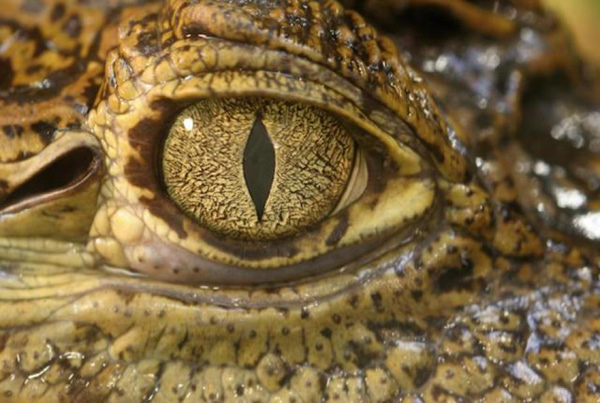当前位置: Language Tips> 双语新闻
Where does the expression ‘crocodile tears’ come from?
几百年来,人们一直习惯用“鳄鱼的眼泪”来比喻虚假的同情和伪装的悔过,为什么鳄鱼的眼泪就是虚伪的呢?鳄鱼真的会在进食的时候为口中的猎物哭泣吗?来看科学家为你解密。

If someone is crying in an attempt to fake remorse or empathy, we say they are shedding “crocodile tears.” But how and why did we start pegging insincere displays of emotion to the toothy reptiles?
如果某人哭泣是为了装出悔过或同情的样子,我们就说他们掉的是“鳄鱼的眼泪”。但是我们是怎样又是为何会把不真诚的感情流露和鳄鱼联系在一起的呢?
The origin may have become popular around the 14th century when a bestselling memoir, The Voyage and Travel of Sir John Mandeville, referenced serpents who sob while eating their human victims.
这个说法大约是在14世纪开始流行起来的,当时有一本畅销的回忆录叫《约翰·曼德维尔爵士的航海旅行》,里面提到蛇在吃人的时候会流泪。
In the centuries since, crying crocodiles have become a metaphor for superficial remorse. The expression has been used as a fable to teach sincere repentance, by Shakespeare to convey false grief, and, more recently, by media mocking tearful politicians or murder suspects.
从那以后的数个世纪以来,哭泣的鳄鱼便被用来比喻虚伪的悔恨。这个表达曾作为寓言用来告诫人们要真心悔悟,也曾被莎士比亚用来指代假意的悲伤,到了现代,则被媒体用于嘲讽流泪的政客或谋杀嫌疑犯。
In 2007, University of Florida zoologist Kent Vliet actually proved that the animals do sob while snacking. But because crocodiles eat while in the water—making a study of their meal-time tears difficult—he studied their close relatives, caimans and alligators, who might dine on dry land. Out of the seven he filmed eating at a Florida alligator park, five teared up before, during, and after eating.
2007年,佛罗里达大学的动物学家肯特·弗利特证明了动物在进食的时候确实会哭泣。但因为鳄鱼是在水中进食的,研究它们进食期间是否会落泪比较困难,所以弗利特就研究了鳄鱼的近亲凯门鳄和短吻鳄,它们会在旱地上进食。他在佛罗里达短吻鳄公园拍摄的七只鳄鱼中,有五只在进食前、进食期间或进食后都会流泪。
Vliet's theory is that when the animals enthusiastically smack their jaws, the movement forces air through the crocodiles’ sinuses and ultimately empties tears into their eyes. Their eyes not only water but can froth and bubble, as Vliet witnessed at the alligator park, where some even teared up in anticipation of their meal of chicks, quail, and feed biscuits.
弗利特的理论是,当动物用力地咀嚼食物时,咀嚼的动作会迫使空气流经鼻窦,从而让眼泪涌出来。据弗利特在短吻鳄公园亲眼目睹,它们的眼睛不但会流泪,还会冒出泡沫,一些鳄鱼甚至在准备吃鸡、鹌鹑和饼干的时候就流下了眼泪。
Vliet was asked to investigate the biology behind the “crocodilian metaphor” by Malcolm Shaner, a UCLA neurologist researching a phenomenon in which some facial palsy sufferers cry when they chew. Doctors often refer to this eye-watering condition as “crocodile tears,” and a 1920s Russian scientist once suggested that such weakened facial muscles allowed "older, possibly crocodilian neurological pathways to emerge" in humans.
弗利特是受加州大学洛杉矶分校的神经学家马尔科姆·沙纳之托来研究“鳄鱼比喻”背后的生物学原理。沙纳正在研究某些面瘫患者在咀嚼时会流泪的现象。医生们通常把这种流泪症状称为“鳄鱼的眼泪”。20世纪20年代的一位俄罗斯科学家曾指出,这种面部肌肉衰弱可能导致人体起用“更古老的或许是鳄鱼式的神经通路”。
由此看来,鳄鱼流泪只是进食时身体产生的一种自然生理现象,和同情悔过毫无关系,难怪人们会将虚伪的哭泣比作鳄鱼的眼泪了。
英文来源:Mental Floss
翻译&编辑:丹妮
上一篇 : 驻华使节点赞政府工作报告
下一篇 :
关注和订阅

电话:8610-84883645
传真:8610-84883500
Email: languagetips@chinadaily.com.cn